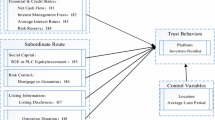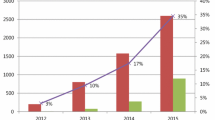Abstract
P2P platform default risk seriously affects the returns of investors, which may cause systemic financial risks. The existing literature mostly focuses on borrower risk, ignoring the research on P2P platform default risk. This paper uses signal theory and data mining-related methods to study the default risk prediction of P2P platforms that integrate soft and hard information signals in different economic environments. First, using the cluster analysis method, the macroeconomic environment of P2P platforms is studied. Second, from the perspective of signal costs, signal theory is used to analyze the impacts of soft and hard information risk signals on platform default in different economic environments. Finally, by integrating the lasso and stacking methods, a LAS-STACK model is proposed to study the prediction of P2P platform default risk in the high-dimensional unbalanced data context. The conclusions of this paper show that the fusion of soft and hard information can better predict the default risk of P2P platforms, especially during periods with low economic levels. Additionally, the LAS-STACK model has a better prediction ability for the P2P platform default risk in the high-dimensional unbalanced data context. This study can improve the ability of regulators and P2P platforms to warn and manage default risks in a specific economic environment and protect investors' returns.










Similar content being viewed by others
Abbreviations
- P2P:
-
Peer-to-peer lending
- LAS-STACK:
-
It is produced by fusion of lasso and stacking
- FA:
-
Hard information features
- FB:
-
Soft information features
- FC:
-
Macroeconomic features
- ICP:
-
A license to operate a website for an internet content provider
- SVM:
-
Support vector machine
- OS:
-
The oversampling method
- US:
-
The undersampling method
- SMOTE:
-
Synthetic minority oversampling technique
- CSL:
-
Cost-sensitive learning
- RF:
-
Random forest
- TP:
-
True positive
- TN:
-
True negative
- FP:
-
False positive
- FN:
-
False negative
- AA:
-
Average accuracy
- FPR:
-
False positive rate (also called Type I error)
- FNR:
-
False negative rate (also called Type II error)
- TPR:
-
True positive rate
- ROC:
-
Receiver operating characteristic curve
- AUC:
-
Area under ROC curve
- SSE:
-
Sum of squared errors within clusters
References
Abdou, H. A., & Pointon, J. (2011). Credit scoring, statistical techniques and evaluation criteria: A review of the literature. Intelligent Systems in Accounting, Finance and Management, 18(2–3), 59–88.
Broecker, T. (1990). Credit-worthiness tests and interbank competition. Econometrica Journal of the Econometric Society, 58(2), 429–452.
Burtch, G., Ghose, A., & Wattal, S. (2014). Cultural differences and geography as determinants of online pro-social lending. Mis Quarterly, 38(3), 773–794.
Bird, R. B., & Smith, E. A. (2005). Signaling theory, strategic interaction, and symbolic capital. Current Anthropology, 38(23), 49–789.
Cebenoyan, A. S., & Strahan, P. E. (2004). Risk management, capital structure and lending at banks. Journal of Banking & Finance, 28, 19–43.
Chen, N., Ribeiro, B., & Chen, A. (2016). Financial credit risk assessment: A recent review. Artificial Intelligence Review, 45(1), 1–23.
Chen, N., Ribeiro, B., Vieira, A. S., Duarte, J., & Neves, J. C. (2011). A genetic algorithmbased approach to cost-sensitive bankruptcy prediction. Expert Systems with Applications, 38(10), 12939–12945.
Chen, P., Wang, C., & Liu, Y. (2015). Real estate prices and firm borrowings: Micro evidence from China. China Economic Review, 36, 296–308.
Dorfleitner, G., Priberny, C., Schuster, S., Stoiber, J., Weber, M., De Castro, I., et al. (2016). Description-text related soft information in peer-to-peer lending—Evidence from two leading european platforms. Journal of Banking & Finance, 64, 169–187.
Ezugwu, A. E., Shukla, A. K., Agbaje, M. B., Oyelade, O. N., José-García, A. & Agushaka, J. O. (2020). Automatic clustering algorithms: a systematic review and bibliometric analysis of relevant literature. Neural Computing and Applications, 1–60.
Finlay, S. (2011). Multiple classififier architectures and their application to credit risk assessment. European Journal of Operational Research, 210, 368–378. https://doi.org/10.1016/j.ejor.2010.09.029
Galar, M., Fernandez, A., Barrenechea, E., Bustince, H., & Herrera, F. (2012). A review on ensembles for the class imbalance problem: bagging-, boosting-, and hybridbased approaches. IEEE Transactions on Systems, Man, and Cybernetics, Part C (Applications and Reviews), 42(4), 463–484.
Gu, D., Zhao, X., & Luo, P. (2020). The signaling behavior of three-player games on P2P platforms. Systems Engineering—Theory & Practice, 40(5), 1210–1220.
Gul, S., Kabak, O., & Topcu, Y. I. (2018). A multiple criteria credit rating approach utilizing social media data. Data and Knowledge Engineering, 116, 80–99.
Haixiang, G., Yijing, L., Shang, J., Mingyun, G., Yuanyue, H., & Bing, G. (2016). Learning from class-imbalanced data: Review of methods and applications. Expert Systems with Applications, 73(12), 220–239.
Hájek, P., Olej, V., & Myskova, R. (2014). Forecasting corporate financial performance using sentiment in annual reports for stakeholders’ decision-making. Technological and Economic Development of Economy, 20(4), 721–738.
Hájek, P., Olej, V., Myšková, R. (2015). Predicting financial distress of banks using random subspace ensembles of support vector machines. In Proceedings of the international conference on artifificial intelligence perspectives and applications (pp. 131–140). Berlin: Springer.
He, H., & Garcia, E. A. (2009). Learning from imbalanced data. IEEE Transactions on Knowledge and Data Engineering, 21(9), 1263–1284.
Ho, T. K. (1998). The random subspace method for constructing decision forests. IEEE Transactions on Pattern Analysis and Machine Intelligence, 20(8), 832–844.
Huang, W., & Zhao, J. L. (2020) Mining marketer-generated content for platform risk signals in P2P lending, 2020. In PACIS 2020 proceedings (p. 89).
Kang, H., & Kang, S. (2021). A stacking ensemble classifier with handcrafted and convolutional features for wafer map pattern classification. Computers in Industry, 129, 103450.
Iyer, R., Khwaja, A. I., Luttmer, E. F. P., & Shue, K. (2016). Screening peers softly: Inferring the quality of small borrowers. Management Science, 62, 1554–1577.
Lee, T. S., Chiu, C. C., Lu, C. J., & Chen, I. F. (2002). Credit scoring using the hybrid neural discriminant technique. Expert Systems with Applications, 23, 245–254. https://doi.org/10.1016/S0957-4174(02)00044-1
Lee, T. S., Chiu, C. C., Chou, Y. C., et al. (2006). Mining the customer credit using classification and regression tree and multivariate adaptive regression splines. Computational Statistics & Data Analysis, 50(4), 1113–1130.
Li, X. (2015). Empirical analysis on the reason of P2P’s closing down. Journal of Financial Development Research, 3, 51–55.
Li, S., Lin, Z., Qiu, J., Safi, R., & Xiao, Z. (2015). How friendship networks work in online P2P lending markets. Nankai Business Review International, 6(1), 42–67.
Liang, K., & He, J. (2020). Analyzing credit risk among Chinese P2P-lending businesses by integrating text-related soft information. Electronic Commerce Research and Applications, 40, 1–14.
Lin, M., Prabhala, N. R., & Viswanathan, S. (2013). Judging borrowers by the company they keep: Friendship networks and information asymmetry in online peer-to-peer lending. Management Science, 59(1), 17–35.
Mahi, H., Farhi, N., Labed, K., & Benhamed, D. (2018). The silhouette Index and the K-harmonic means algorithm for multispectral satellite images clustering. In 2018 international conference on applied smart systems (ICASS) (pp. 1–6). IEEE.
Morton, H. (2011). Municipal credit rating modelling by neural networks. Decision Support Systems, 51(1), 108–118.
Neuberger, D., & Räthke-Döppner, S. (2015). The role of demographics in small business loan pricing. Small Business Economics, 44(2), 411–424.
Omran, M. G., Engelbrecht, A. P., & Salman, A. (2007). An overview of clustering methods. Intelligent Data Analysis, 11(6), 583–605.
Paul, S. (2014). Creditworthiness of a borrower and the selection process in micro-finance: A case study from the urban slums of India. Margin: The Journal of Applied Economic Research, 8(1), 59–75.
Pennathur, A. K. (2001). ‘“Clicks and bricks”’: E-risk management for banks in the age of the internet. Journal of Banking & Finance, 25(11), 2103–2123.
Perkins, S. J., & Hendry, C. (2005). Ordering top pay: Interpreting the signals. Journal of Management Studies, 42, 1443–1468. https://doi.org/10.1111/j.1467-6486.2005.00550.x
Pham, T., & Talavera, O. (2018). Discrimination, social capital, and financial constraints: The case of Viet Nam. World Development, 102, 228–242.
Rosenberg, E., & Gleit, A. (1994). Quantitative methods in credit management:A survey. Operations Research, 42, 589–613.
Sun, J., & Li, H. (2008). Listed companies’ fifinancial distress prediction based on weighted majority voting combination of multiple classififiers. Expert Systems with Applications, 35, 818–827. https://doi.org/10.1016/j.eswa.2007.07.045
Tsai, C. F., Hsu, Y.-F., & Yen, D. C. (2014). A comparative study of classififier ensembles for bankruptcy prediction. Applied Soft Computing, 24, 977–984.
Tu, J., & Tong, Z. (2016). Risk reserve, loan default, and run on P2P lending platforms. Financial Theory and Practice, 2, 27–31.
Wang, G., Chen, G., & Chu, Y. (2018). A new random subspace method incorporating sentiment and textual information for financial distress prediction. Electronic Commerce Research and Applications, 29, 30–49.
Wang, G., Hao, J., Ma, J., & Jiang, H. (2011). A comparative assessment of ensemble learning for credit scoring. Expert Systems with Applications, 38(1), 223–230.
Wiginton, J. C. (1980). A note on the comparison of logit and discriminant models of consumer credit behaviour. Journal of Financial and Quantitative Analysis, 15, 757–770.
Wu, D., Lin, C. T., Huang, J., & Zeng, Z. (2019). On the functional equivalence of TSK fuzzy systems to neural networks, mixture of experts, CART, and stacking ensemble regression. IEEE Transactions on Fuzzy Systems, 28(10), 2570–2580.
Xiao, S., & Dong, M. (2015). Hidden semi-Markov model-based reputation management system for online to offline (O2O) e-commerce markets. Decision Support Systems, 77, 87–99.
Xie, C., & Wang, J. (2015). Research on credit risk of P2P network lending platform. Finance, 5(1), 1–5.
Xing, H., Sun, N., & Chen, Y. (2012). Credit rating dynamics in the presence of unknown structural breaks. Journal of Banking & Finance, 36(1), 78–89.
Xiong, T., Wang, S., Mayers, A., & Monga, E. (2013). Personal bankruptcy prediction by mining credit card data. Expert Systems with Applications, 40(2), 665–676.
Yan, Y., Lv, Z., & Hu, B. (2017). Building investor trust in the p2p lending platform with a focus on Chinese p2p lending platforms. Electronic Commerce Research, 18, 203–224.
Yoon, Y., Li, Y., & Feng, Y. (2018). Factors affecting platform default risk in online peer-to-peer (p2p) lending business: An empirical study using chinese online p2p platform data. Electronic Commerce Research, 19, 131–158.
Zadegan, S. M., Mirzaie, M., & Sadoughi, F. (2013). Ranked k-medoids: A fast and accurate rank-based partitioning algorithm for clustering large datasets. Knowledge-Based Systems, 39, 133–143.
Zhang, H., Li, J. L., Liu, X. M., & Dong, C. (2021). Multi-dimensional feature fusion and stacking ensemble mechanism for network intrusion detection. Future Generation Computer Systems, 122, 130–143.
Acknowledgements
The authors have declared that no conflicts of interest exist. I would like to declare on behalf of my coauthors that the work described is original research that has not been published previously and is not under consideration for publication elsewhere, in whole or in part. This research is supported by the Science Foundation of the Ministry of Education of China (No. 18YJC630082), the National Natural Science Foundation of China (No. 71731005), and the Natural Science Foundation of Anhui Province (No. 1908085QG307).
Author information
Authors and Affiliations
Corresponding author
Additional information
Publisher's Note
Springer Nature remains neutral with regard to jurisdictional claims in published maps and institutional affiliations.
Rights and permissions
About this article
Cite this article
Liang, K., Zhang, C. & Jiang, C. Analyzing default risk among P2P platforms based on the LAS-STACK method by considering multidimensional signals under specific economic contexts. Electron Commer Res 22, 77–111 (2022). https://doi.org/10.1007/s10660-021-09505-9
Accepted:
Published:
Issue Date:
DOI: https://doi.org/10.1007/s10660-021-09505-9




